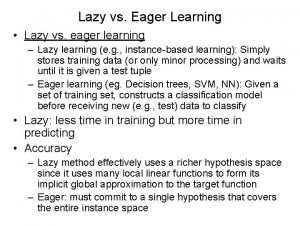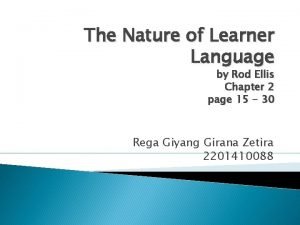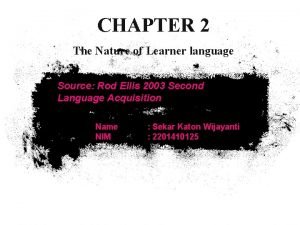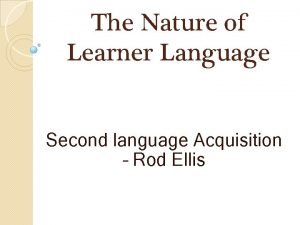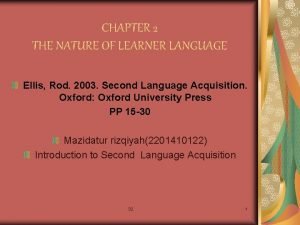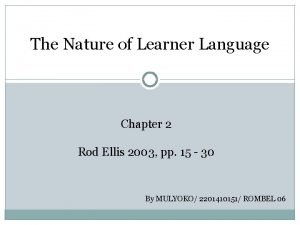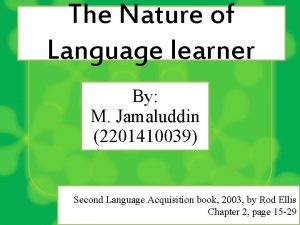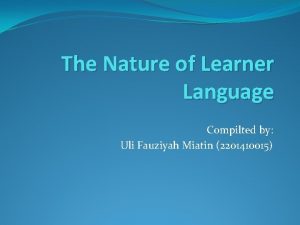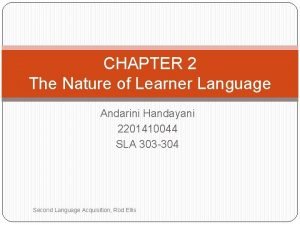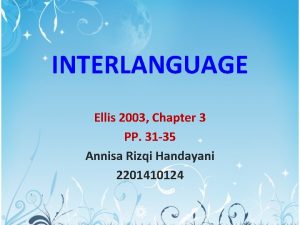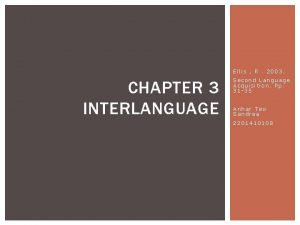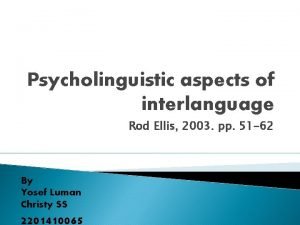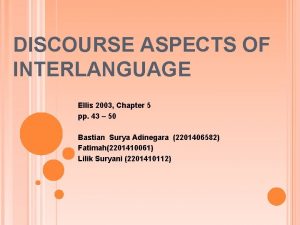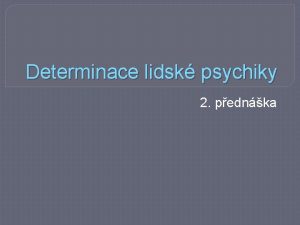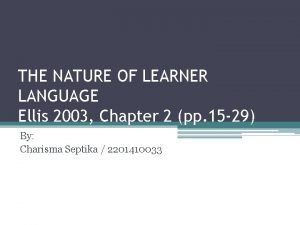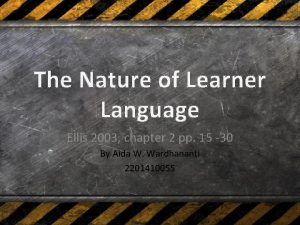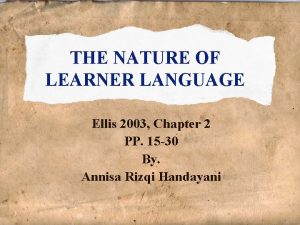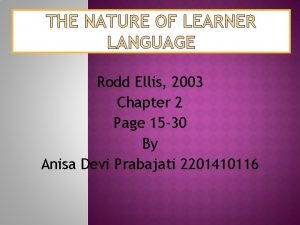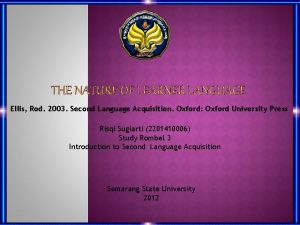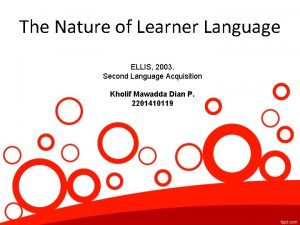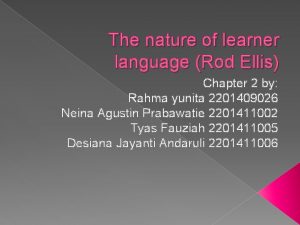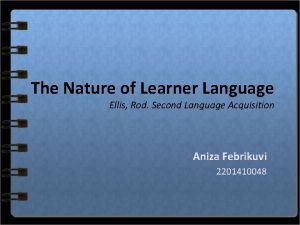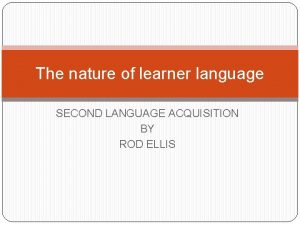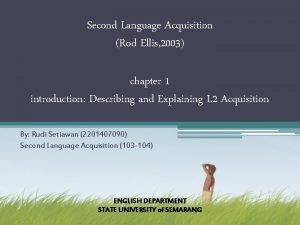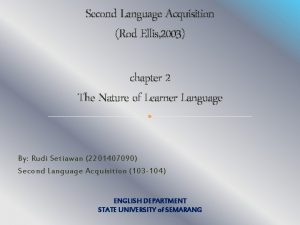THE NATURE OF LEARNER LANGUAGE Ellis 2003 Chapter

















- Slides: 17

THE NATURE OF LEARNER LANGUAGE Ellis 2003, Chapter 2 pp. 15 – 30 Amaliah Khairina

q Errors and errors analysis q Developmental pattern q Variability in learner language

Errors and Errors Analysis Ø Some good reasons for focusing on errors : 1. They are a conspicuous feature of learner language, raising the important question ‘why do learners make errors? ’ 2. It is useful for teachers to know what errors learners make. 3. Paradoxically, it is possible that making errors may actually help learners to learn when they self – correct the error they make.

Ø Error and errors analysis § Identifying errors § Describing errors § Explaining errors § Error evaluation :

ØIdentifying Errors �To identify errors we have to compare the sentences learners produce with what seem to be the normal or ‘correct’ sentences in the target language which correspond with them.

Ø How can we distinguish errors and mistake? To check the consistency of learners’ performance. If they consistently substitute ‘contain’ for ‘contained’ this would indicate a lack of knowledge – an error.

Ø Describing Errors �There are several ways of doing this : 1. To classify errors into grammatical categories. 2. To try to identify general ways in which the learners’ utterances differ from the reconstructed target – language utterances.

Ø Explaining Errors �Errors are, to a large extent, systematic and, to a certain extent, predictable. � Errors are not systematic; many of them are also universal.

ØError evaluation �Purpose of the error analysis : to help learners learn an L 2, there is a need to evaluate errors. ERRORS • • 1. Global errors 2. Local errors

1. Global error violate : the overall structure of a sentence and for this reason may make it difficult to process. 2. Local error affect : onlyasingleconstituentin the sentence and are perhaps less likely to create any processing problems.

Ø Developmental Patterns We can explore the universality of L 2 acquisition by examining the developmental pattern learners. The patterns are : 1. The early stages of L 2 Acquisition 2. The order of acquisition 3. Sequence of acquisition 4. Some implication

1. The early stages of L 2 q. We can find out how a language is learned as a natural, untutored process by investigating what learners do when exposed to the L 2 in communicative setting. q The characteristics are : 1. One is the kind of formulaic chunks which we saw in the case studies. 2. Propositional simplification.

2. The order of acquisition Ø To investigate the order of acquisition, researchers do : 1. Choose a number of grammatical structures to study 2. Collect samples of learner language and identify how accurately each feature is used by the learners. Accuracy order means that the researchers rank the features according to how accurately each feature is used by the learners.

3. Sequence of acquisition How L 2 learners acquire irregular paste tense forms. Stage Description Example 1 Learners fail to mark the verb for past tense ‘eat’ 2 Learners begin to produce irregular ‘ate’ 3 Learners over generalize the regular past tense form ‘eated’ 4 Sometimes learners produce hybrid forms ‘ated’ 5 Learners produce correct irregular past tense forms ‘ate’

4. Some implications The work on developmental patterns is important for another reason. It suggests that some linguistic features (particularly grammatical inherently easier to learn than others. ones) are

ØVariability in Learning Language �Learner language is variable �Learners sometimes employ one form and sometimes another �One type of error may alternate with another type �An error may alternate with the correct target - language

v Important factor that accounts for the systematic of variability : 1. Linguistic Context The effect of linguistic context are also evident in learner use of the verb ‘to be’. 2. Situational Context Learners vary their use of language similarity. 3. Psycholinguistic Context Whether learners have the opportunity to plan their production.
 Lazy learning vs eager learning
Lazy learning vs eager learning The nature of learner language
The nature of learner language The nature of learner language
The nature of learner language The nature of learner language
The nature of learner language The nature of learner language
The nature of learner language The nature of learner language
The nature of learner language The+nature+of+language+learner
The+nature+of+language+learner Compilted
Compilted The nature of learner language
The nature of learner language Ellis 2003
Ellis 2003 Ellis 2003
Ellis 2003 Rod ellis 2003
Rod ellis 2003 Rod ellis 2003
Rod ellis 2003 Discourse aspects of interlanguage
Discourse aspects of interlanguage Nature and nature's laws lay hid in night
Nature and nature's laws lay hid in night Nature nature controversy
Nature nature controversy Hát kết hợp bộ gõ cơ thể
Hát kết hợp bộ gõ cơ thể Ng-html
Ng-html
